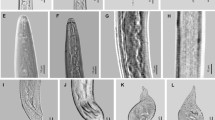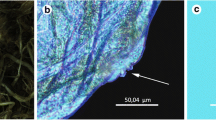Abstract
The rice root-knot nematode, Meloidogyne graminicola is an important pathogen, impacting rice, wheat and possibly vegetable production in South-East Asia. Ten isolates of M. graminicola from broad geographic areas were compared using traditional and molecular methods. Total body length, oesophageal length, maximum body width and tail length were measured in 40 juveniles and the perineal patterns of 10 females per isolate were compared. Pathogenicity was determined on a variety of hosts. The internally transcribed spacer (ITS) region was amplified and sequenced to confirm the identity and phylogenetic relationships of the isolates. Substantial variation observed in morphometric measurements among and within isolates did not correlate with the geographic source of the isolates. All the isolates were similar in host range, but the M. graminicola-Florida isolate differed from the other nine isolates in that it was not pathogenic to rice cvv. Labelle, LA 110, Cocodrie, BR 11 or Mansuli, suggesting that M. graminicola consists of more than one race. ITS sequences of all 10 isolates matched with those of M. graminicola in GenBank and formed a single clade in the phylogenetic analysis with minor variations among and within isolates. Multiple ITS sequences occurred within individual juveniles in some of the isolates.
Similar content being viewed by others
References
Baicheva O, Salkova D, Palazova G (2002) Root-knot nematodes (Meloidogyne, Goeldi, 1987) - species composition, pathogenicity, some problems for investigation. Experimental Pathology and Parasitology 5, 21–24.
Bernard EC, Eisenback JD (1997) Meloidogyne trifoliophila n. sp. (Nemata: Meloidogynidae), a parasite of clover from Tennessee. Journal of Nematology 29, 43–54.
Birchfield W (1965) Host-parasite relations and host range status of a Meloidogyne species in southern USA. Phytopathology 55, 1359–1361.
ba]Bridge J, Michel L, Sikora RA (1990) Nematode parasites of rice. In ‘Plant parasitic nematodes in subtropical and tropical agriculture’. (Eds M Luc, RA Sikora, J Bridge) pp. 69–108. (CAB International: Wallingford, UK)
Brito JA, Centinas R, Powers TO, Inserra RN, McAvoy EJ, Mendes ML, Crow TW, Dickson DW (2004) Identification and host preference of Meloidogyne mayaguensis and other root-knot nematodes from Florida and their susceptibility to Pasteuria penetrans. Journal of Nematology 36, 308–309. [Abstract]
Cherry T, Szalanski AL, Todd TC, Powers TO (1997) The internal transcribed spacer region of Belonolaimus (Nemata: Belonolaimidae). Journal of Nematology 29, 21–29.
Duxbury JM (2001) Sustainability of post-green revolution agriculture: the rice-wheat cropping system of South Asia. Annual Report (10 February 2001-30 September 2002). Submitted to the Soil Management CRSP Management Entity, University of Hawaii.
Gaur HS, Sharma SN (1999) Relative efficacy of bioassay and extraction of juveniles from soils for detection and estimation of population levels of the root-knot nematodes. Meloidogyne graminicola and M. triticoryzae. Annals of Plant Protection Sciences 7, 75–79.
Gergon EB, Miller SA, Halbrendt JM, Davide RG (2002) Effect of rice root-knot nematode on growth and yield of yellow Granex onion. Plant Disease 86, 1339–1344. doi:10.1094/PDIS.2002.86.12.1339
Handoo ZA, Klassen W, Abdul-Baki A, Bryan HH, Wang Q (2003) First record of rice root-knot nematode (Meloidogyne graminicola) in Florida. Journal of Nematology 35, 342. [Abstract]
Handoo ZA, Skantar AM, Carta IK, Erbe EF (2005) Morphological and molecular characterization of a new root-knot nematode, Meloidogyne thailandica n. sp. (Nematoda: Meloidogynidae), parasitizing ginger (Zingiber sp.). Journal of Nematology 37, 343–353.
Hugall A, Stanton J, Moritz C (1999) Reticulate evolution and the origins of ribosomal internal transcribed spacer diversity in apomictic Meloidogyne. Molecular Biology and Evolution 16, 157–164.
Hussay HS, Janseen GJW (2002) Root-knot nematode: Meloidogyne species. In ‘Plant resistance to parasitic nematodes’. (Eds JL Starr, R Cook, J Bridge) pp. 43–70. (CAB International: Wallingford, UK)
Jepson SB (1987) ‘Identification of root-knot nematodes (Meloidogyne species).’ (CAB International: Wallingford, UK)
Maas PW, Sanders H, Dede J (1978) Meloidogyne oryzae n. sp. (Nematoda, Meloidogynidae) infesting irrigated rice in Surinam (South America). Nematologica 24, 305–311.
Manser DP (1971) Notes on the rice root-knot nematode in Laos. FAO Plant Protection Bulletin 19, 136–139.
McDonald BA, Linde C (2002) The population genetics of plant pathogens and breeding strategies for durable resistance. Euphytica 124, 163–180. doi:10.1023/A:1015678432355
McGowan JB, Langdon KR (1989) Host of the rice root-knot nematode Meloidogyne graminicola. Nematology circular, No. 172. Florida Department of Agriculture, Gainesville, Florida, USA
Mercer CF, Starr JL, Miller KL (1997) Host-parasite relationships of Meloidogyne trifoliophila isolates from New Zealand. Journal of Nematology 29, 55–64.
Minton NA, Tucker ET, Golden AM (1987) First report of Meloidogyne graminicola in Georgia. Plant Disease 71, 376. doi:10.1094/PD-71-0376C
Mulk MM (1976) ‘Meloidogyne graminicola. C.I.H. description of plant of plant parasitic nematodes, Set 6, No. 87.’ (CAB International: Wallingford, UK)
Padgham JL (2003) Impact of the rice root-knot nematode (Meloidogyne graminicola) on lowland rainfed rice in Northern Western Bangladesh. PhD Thesis, Cornell University, Ithaca, New York.
Padgham JL, Mazid MA, Duxbury JM, Abawi GS, Hossain M (2004) Yield loss caused by Meloidogyne graminicola on lowland rainfed rice in Bangladesh. Journal of Nematology 36, 42–48.
Pokharel RR (2007) Characterization of root-knot nematodes from ricewheat fields in Nepal and search for source of resistance. PhD Thesis, Cornell University, Ithaca, NY.
Pokharel RR, Abawi GS, Duxbury JM, Smart C (2004) Characterization of root-knot nematodes recovered from rice-wheat fields in Nepal. Journal of Nematology 36, 341–342. [Abstract]
Pokharel RR, Abawi GS, Duxbury JM, Smart C (2005) Reproductive fitness of isolates of Meloidogyne graminicola from Nepal on selected rice and wheat varieties. Journal of Nematology 37, 388. [Abstract]
Pokharel RR, Abawi GS, Duxbury JM, Zhang N, Smart C (2007) Characterization of root-knot nematodes from rice-wheat production fields in Nepal. Journal of Nematology 39, 221–230.
Power TO, Mullin PG, Harris TS, Sutton LA, Higgins RS (2005) Incorporating molecular identification of Meloidogyne spp. into a large-scale regional survey. Journal of Nematology 37, 226–235.
Santo GS, Pinkerton JN (1985) A second race of Meloidogyne chitwoodi discovered in Washington. Plant Disease 69, 631.
SAS Institute (1990) ‘SAS user’s guide. Version 6.0.’ 4th edn. (SAS Institute: Cary, NC)
Sasser JN, Triantaphyllou AC (1977) Identification of Meloidogyne species and races. Journal of Nematology 9, 283.
Soomro MH, Hauge NGM (1992) Relationship between inoculum density of Meloidogyne graminicola, growth of rice seedling and development of the nematode. Pakistan Journal of Nematology 11, 103–114.
Swofford D (2001) ‘Phylogenetic analysis using Parsimony (PAUP) 4.0B8.’ (Sinauer Associates Inc.: Sunderland, MA)
Szalanski AL, Sui DD, Harris TS, Powers TO (1997) Identification of cyst nematodes of agronomic and regulatory concern by PCR-RFLP of ITS1. Journal of Nematology 29, 255–264.
Thiery M, Mugniery D, Fouville D, Schots A (1996) Hybridization naturelles entre Globodera rostochinensis et G. pallida. Fundamental and Applied Nematology 19, 437–442.
Triantaphyllou AC (1985) Cytogenetics, cytotaxonomy and phylogeny of root-knot nematodes. In ‘An advance treatise on Meloidogyne. Vol. I. Biology and control’. (Eds JN Sasser, CC Carter) pp. 113–126. (North Carolina State University: Raleigh, NC)
Van der Beek JG, Maas PWTH, Janseen GJ, Zijistra C, Van Silfhout CH (1999) A pathotype to describe intra-specific variation in pathogenicity of Meloidogyne chitwoodi. Journal of Nematology 31, 386–392.
Windham GL, Penderson GA (1992) Comparison of reproduction by Meloidogyne graminicola and M. incognita on Trifolium species. Journal of Nematology 24, 257–261.
Yik CP, Birchfield W (1979) Host studies and reactions of cultivars to Meloidogyne graminicola. Phytopathology 69, 497–499. doi:10.1094/ Phyto-69-497
Zahid MI, Nobbs J, Gurr GM, Hodda M, Nikandrow A, Fulkerson WJ, Nicol H (2001) Effect of the clover root-knot nematode (Meloidogyne trifoliophila) on growth of white clover. Nematology 3, 437–446. doi:10.1163/156854101753250764
Zijlstra CE, Lever M, Uenk BJ, Van Sithout CH (1995) Differences between ITS regions of isolates of root-knot nematodes Meloidogyne hapla and M. chitwoodi. Phytopathology 85, 1231–1237. doi:10.1094/Phyto-85-1231
Author information
Authors and Affiliations
Corresponding author
Rights and permissions
About this article
Cite this article
Pokharel, R.R., Abawi, G.S., Duxbury, J.M. et al. Variability and the recognition of two races in Meloidogyne graminicola . Australasian Plant Pathol. 39, 326–333 (2010). https://doi.org/10.1071/AP09100
Received:
Accepted:
Issue Date:
DOI: https://doi.org/10.1071/AP09100




